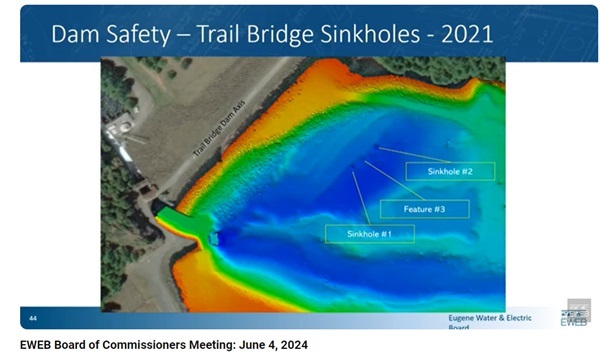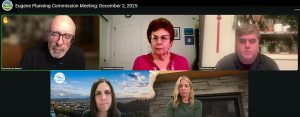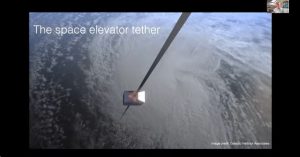Facing sinkholes and seismic threats, EWEB to discuss future of Carmen-Smith
6 min read
Sinkholes in a reservoir, and a fault zone closer to the project than previously reported, are delaying the Carmen-Smith hydroelectric project. At the June 4 EWEB board meeting:
Lisa Krentz (EWEB generation manager): All right, so I’m going to talk a bit about economic changes. As you’re aware, this comes up almost every board meeting: The budget projections for the project have changed significantly since the initial 2016 project estimate of $139 million. Our current estimate puts completion of all the required projects in the license and settlement agreement at $194 million. That does also include powerhouse upgrades.
[00:00:40] So I wanted to provide some examples of what is driving that escalation. So overall, schedule delays have not been our friend. They have made us susceptible to inflation and supply chain issues. And then there’s dam safety concerns, both known and emergent, that have expanded the scope of many projects.
[00:0:59] Mindy Schlossberg (EWEB commissioner): So I just have a, like, bigger question. It’s: When do we really talk about Carmen-Smith?… I mean, we talked about our improvement plan and how much it costs and where can we turn the dials and things like that. And then we’ve seen that this is like, what, like, $60 million over budget, environmentally problematic, and we’ve got risks of fires now. We have low water years.
[00:01:29] Like, when do we have this higher-level discussion about what, do we want to keep throwing money at this project? I mean, I don’t know what our options are. I know that we’re committed to locally generating power, but how many more sinkholes will come up? And we talk about what our portfolio is going to look like.
[00:01:46] Anyway. I just wonder when do we talk about Carmen in a bigger picture?
[00:01:52] Lisa Krentz (EWEB generation manager): So I think we’re going to start that discussion in the fall. And I am looking at (General Manager) Frank (Lawson) to see if he wants to chime in but that was one of the thoughts for the fall in conjunction with the integrated resource plan is to have a broader value discussion.
[00:02:05] Frank Lawson (EWEB general manager): Yeah, Lisa is correct. I think looking at the business model for the electric utilities specifically, presently we’re completely vertically integrated on the electric side, and so having that assessment and analysis, and talk about the tradeoffs between having and owning and operating our own generation as part of that, will be part of that discussion.
[00:02:27] That said, that does not remove our obligation under the license that we presently have. But having that higher-level discussion should inform a number of directional decisions around resources.
[00:02:39] John Q: Commissioner Schlossberg raised her question at the June 4 board meeting, after a presentation by Lisa Krentz.
[00:02:46] Lisa Krentz (EWEB generation manager): I’m Lisa Krentz, generation manager, here to provide an update on the deployment of the Carmen-Smith hydroelectric project operating license… Now, a lot has happened since we last spoke to you in September.
[00:02:59] As the board is aware, in October of 2023, just last year, both the National Marine Fisheries Service and U.S. Fish and Wildlife Service filed letters of noncompliance with FERC (Federal Energy Regulatory Commission) that included allegations that EWEB had intentionally delayed license-required projects and acted in bad faith.
[00:03:14] EWEB filed a comprehensive response to FERC in November, which you’ve all seen, and at the request of the federal fish agencies also convened the Settlement Agreement Policy Committee, which is essentially a procedural step to allow parties to withdraw from the settlement agreement.
[00:03:32] In December, National Marine Fisheries Service did just that, by filing their notice of withdrawal from the settlement agreement and requesting that FERC, as the federal action agency, reinitiate Endangered Species Act (ESA) consultation for Upper Willamette Spring Chinook salmon. In January, U.S. Fish and Wildlife Service followed suit by also withdrawing from the settlement agreement and requesting ESA consultation for bull trout.
[00:03:55] And in April, FERC issued an order to EWEB responding to numerous EWEB filings, extension of time requests, and general project status. In that order, FERC granted several extension-of-time requests that were outstanding, and required that EWEB file responses for three specific projects. Our planned submissions for those are currently under review by the Fish Working Group and will be submitted to FERC in the next month or so.
[00:04:22] FERC also stated that EWEB is out of compliance with several license articles, including permanent upstream and downstream fish passage in Smith Bypass Reach habitat. Notably, FERC did not address the request from National Marine Fisheries Service and U.S. Fish and Wildlife Service to reinitiate Endangered Species Act consultation.
[00:04:41] And then finally, just last week, four nongovernmental organizations—Cascadia Wildlands, Oregon Wild, American Whitewater, and Willamette Riverkeeper—filed a letter with FERC in response to their April order, noting many of the same concerns as the fall letter from the federal fish agencies.
[00:04:57] John Q: EWEB obtained new information about the White Branch fault zone, and sinkholes.
[00:05:05] Mark Zinniker (EWEB, Generation): Seismic discoveries in 2020: improved imaging, LIDAR imaging, revealed that the White Branch Fault Zone did not stop at the Belknap Hot Springs, rather it extended north all the way beyond Clear Lake, in close proximity to the Carmen project, shifting our understanding of the seismic hazard. It’s not the major Cascadia event, but rather it’s a local, close-proximity fault zone that is controlling our seismicity.
[00:05:30] And then of course at Trail Bridge, May of 2021, it was the discovery of sinkholes in the Trail Bridge Reservoir, triggering extensive investigations so that we could understand how those sinkholes would interact with the planned fish passage improvements at the spillway and at the trap and haul facility.
[00:05:48] John Q: One commissioner called the recent correspondence “weird.”
[00:05:53] Sonya Carlson (EWEB commissioner): It’s both shocking to me and odd at the same time that we would get these weird letters when we’ve been working with them throughout this entire process. And people and organizations that originally signed on to these same plans with that similar information have, like, turned a complete blind eye in these last recent years to all of these other things that have gone on that have caused delays. It’s just my observation, but I think it’s very odd.
[00:06:22] Matt McRae (EWEB commissioner): I’ve been following the FERC docket and that April letter from FERC is concerning to me. The language, the rhetoric, you know, it seems like it keeps getting heightened each time we hear from the federal agency and this one feels like FERC is, is saying, Hey, you know, you guys have to take some action here.
[00:06:41] They’re pretty plain about that. I’m curious what our plan is to change course to meet the requirements that FERC and the federal fish agencies are putting in front of us. Given that it’s very difficult—we have seismic issues, you know, all the challenges we have in front of us—I’m curious what our plan is to change course so that we’re In compliance with FERC’s requirements.
[00:07:06] Lisa Krentz (EWEB generation manager): Yeah, it’s a really good question and unfortunately another complicated one. In a nutshell, we’re doing what we can, but there is not a feasible way to construct fish passage next year, next week, or even in two years, we have very significant and concerning dam safety and regulatory review processes that we have to go through and cannot sideline.
[00:07:32] Matt McRae (EWEB commissioner): I don’t expect, I guess, a perfect resolution tonight, but I will be curious to hear what our plan is to make sure that we’re not in a spot where we’re getting sideways with FERC and exposed to greater, you know, potential financial penalties, or the like.
[00:07:50] John Barofsky (EWEB commissioner): For me personally, as a commissioner, I am passionate about maintaining the watershed as a healthy part of our ecosystem and doing whatever we can as a utility to help bolster that ecosystem, but there’s only so far that I think we can go as a publicly-owned utility.
And I think we have done a lot of good work and I hope we continue to do a lot of good work on the McKenzie and the watershed to restore habitat and bring back our threatened species. Whether or not Trail Bridge and Carmen-Smith are the thing that will do that, I’m not sure at this point, but I am committed to doing whatever we can to help maintain our ecosystem on the McKenzie and Upper Willamette.
[00:08:41] John Q: This fall, commissioners and staff plan to discuss the future of the Carmen-Smith hydroelectric project.



